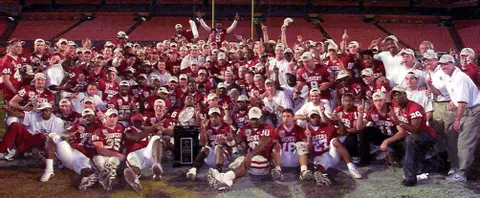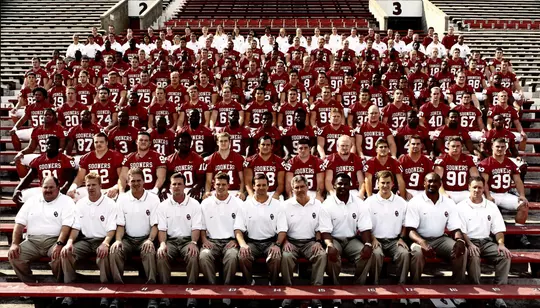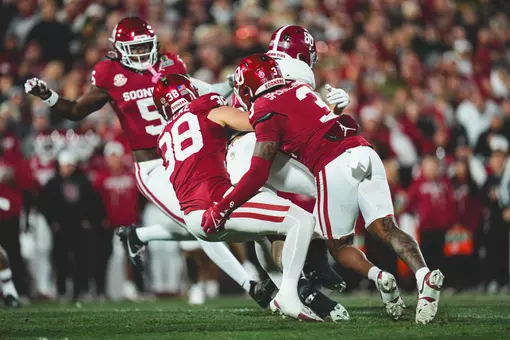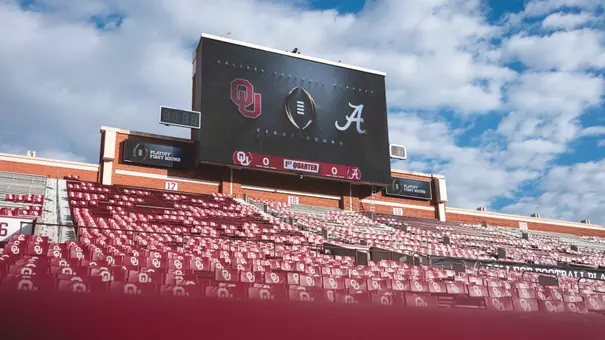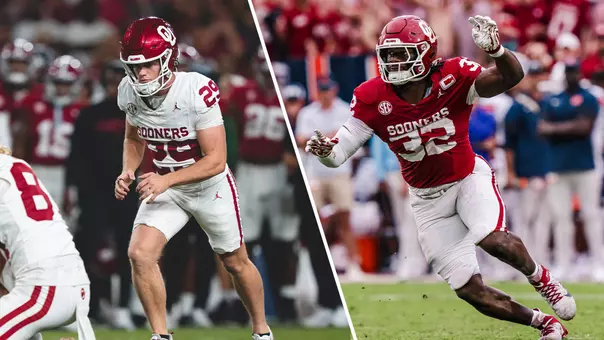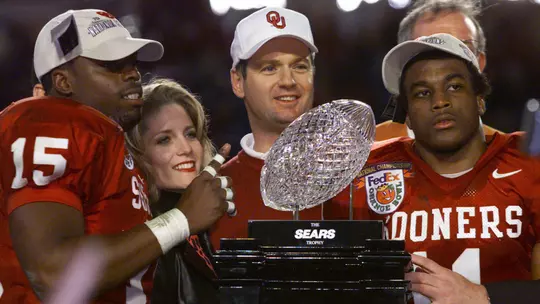
20 Years Later, Still Magical
John Rohde
11/19/2021
N o singular moment defined Oklahoma’s journey to the 2000 football national championship. There wasn’t one play, one drive, one game or one week that brought the Sooners their seventh national title. There was, however, one month that catapulted the Sooners skyward.
Red October.
Those who recall what transpired 20 years ago know it was not an isolated case of Sooner Magic that brought home another national crown to OU. Instead, the entire 2000 season was magical.
T he quest began with the Sooners at No. 19 in The Associated Press preseason poll.
When September was finished, the 4-0 Sooners were up to No. 10.
When October was complete, the 7-0 Sooners were at No. 1, receiving 69 of the 70 first-place votes.
When November had passed, the 11-0 Sooners were atop the polls as the nation’s lone unbeaten team and bound for the Big 12 Championship game in a rematch against formidable Kansas State.
OU survived the Wildcats 27-24 at Arrowhead Stadium to claim its first Big 12 title, setting up a national championship game at the Orange Bowl against defending national champion Florida State and 28-year-old Heisman Trophy winner Chris Weinke. Despite being the lone unbeaten and ranked No. 1, the Sooners were pegged anywhere from 10- to 13-point underdogs.
Battling a hand injury he suffered early in the week, OU quarterback and Heisman Trophy runner-up Josh Heupel surgically executed what needed to be done. Meanwhile, a smothering OU defense held one of the nation’s top offensive teams (549.0 total yards and 42.4 points per game) to 301 total yards and zero points in a 13-2 victory.
Alas, perfect symmetry evaded the Sooners when a snap from center on a punt attempt sailed high over the head of punter Jeff Ferguson. Standing at his own 20-yard line, a hustling Ferguson sprinted back to the 3, scooped up the ball and downed it in his own end zone for a safety to prevent a tap-in touchdown for the Seminoles with 55 seconds left in the game.
“Fantastic play,” OU head coach Bob Stoops said of Ferguson’s effort. “There was still enough time left (for an FSU comeback). That would have been a lot to sweat out.”
Had the safety not occurred, the Sooners could have completed its 13-0 season with a 13-0 victory in the national championship game. “That would have been storybook,” two-time All-American linebacker Rocky Calmus said. “You couldn’t have written it any better.”
That’s OK. We still scored all the points in that last game.Bob Stoops
W hat exactly was the Sooners’ seminal moment in 2000? When did they know they had what it took to win the program’s first national championship since 1985?
“That incites quite the conversation when you ask it that way,” third-team all-conference center Bubba Burcham said with a chuckle.
Asked to help explain the inner workings of the year 2000 were Calmus, all-everything defender Roy Williams, wide receiver Josh Norman, Burcham and Stoops – two defensive players, two offensive players and that season’s national coach of the year.
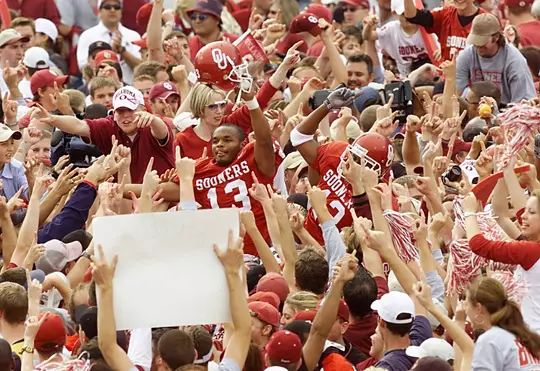
Red October
A s expected, OU opened the season with four straight victories at home against UTEP, Arkansas State, Rice and Kansas. Average margin of victory: 31.2 points.
The Sooners’ degree of difficulty in October would be considerably higher, bordering on impossible.
Oct. 7 – vs. No. 11 Texas (Dallas)
Oct. 14 - at No. 2 Kansas State
Oct. 28 – vs. No. 1 Nebraska
OU’s merciless stretch in the schedule was the topic of conversation for months leading up to the season and has been discussed incessantly ever since.
To this day, in the 25-year history of Big 12 football, no team has endured a back-to-back-to-back conference slate nearly as formidable. The Sooner faithful proclaimed it as “Red October.”
Asked to select the season’s pivotal moment, Stoops pointed to the first Saturday in October. “To me, what started it all was Texas,” Stoops said of a stunning 63-14 dismemberment of their Red River rival at the Cotton Bowl.
With 4:43 left in the second quarter, OU had built a 42-0 lead against the Longhorns.
“We’re up 42-0… and it’s not stopping,” Stoops said of his team’s domination. “I remember coaches talking to each other over the headphones and I said:
‘You know what, boys? We’re pretty good.’
"And that was me saying it in the second quarter. That kind of proved we were pretty decent. It just gave us a ton of confidence.”
As convincing as the 39-point victory was, the Sooners potentially could have scored in the 70s, maybe higher, had Stoops not taken his foot of the pedal. “Oh, easily in the 70s,” Stoops said. “We definitely throttled back as much as we could (in the second half).”
“We had hung 40 (points) before on people and won, but not 60,” Burcham said. “And certainly not against Texas. That was a big deal.”
The following week at Kansas State, the Sooners again pounced quickly, led 31-14 at halftime and extended their lead to 38-14 early in the third quarter.
The resilient Wildcats countered by reeling off 17 consecutive points in a span of just 9:26 to pull within 38-31 in a frenzied atmosphere.
How did OU react in that moment? “Everybody was real calm,” Heupel said after the game. “We were poised and ready to go out. We knew we had to put a drive together and try to get some more points.”
After a K-State touchdown on a blocked punt cut the OU lead to seven with 10:31 to go, Heupel calmly drove the Sooners downfield and Tim Duncan’s 40-yard field goal with 3:27 left helped secure the 41-31 win.
On Dec. 2, OU again would beat KSU to win the Big 12 Championship Game at Kansas City, Mo.
“Beating K-State twice in one year was hard,” Williams said. “They had such speedy receivers. I felt like we were just chasing our tails because those dudes were so fast with all that space.”
Unlike the first two games of Red October, the Sooners were stunned early as top-ranked Nebraska took a 14-0 lead less than seven minutes into the game at Owen Field behind future Heisman winner Eric Crouch.
But the Huskers wouldn’t score again. OU closed with 31 unanswered points, including 24 in an explosive second quarter, to post a 31-14 victory. The Sooners contained the nation’s top rushing offense (349.3 per game) to 195 yards on 43 attempts.
When an undefeated Red October came to an end, Burcham came to a realization.
“We were pretty confident we could hang with almost anybody,” he said. “After we had done those things, we were like, ‘Hey, we’re pretty good. We’re going to keep fighting. We’re going to keep playing and we’re going to win these games.’ It was a belief, I think, that was different. Each game it became, ‘What challenges are there going to be that we’re going to have to overcome?’”
Little did Burcham know what awaited the Sooners on Nov. 11 at Texas A&M.
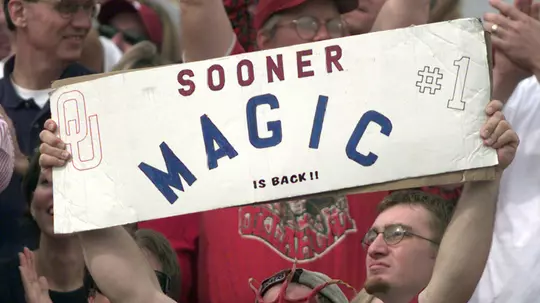
Welcome to Aggieland
A n overflow gathering of 53,011 rabid fans was on hand at Kansas State. The monstrosity that is Kyle Field drew a crowd of 87,188 when OU came to College Station.
The game at KSU Stadium was a deafening din, and the persistently swaying “Home of the 12th Man” wasn’t much quieter.
“They smelled blood,” Stoops said of the crowds in Manhattan and College Station. “Their crowds were ready for us.”
To this day, members of the 2000 national championship team agree the loudest crowd they ever heard was in Manhattan on Oct. 14.
“When K-State blocked that punt late in the game for a touchdown to get within seven (points), you couldn’t talk to the person next to you without having your headphones on,” said Stoops, who is quite familiar with KSU home games having served as an assistant there from 1989-95 to help manufacture what remains the most impressive program turnaround in college football history.
“Manhattan, by far, was the loudest stadium I’ve ever been in,” Norman said.
“Truthfully, I had never been in an environment like that,” Burcham said.
In a span of one month, the visiting Sooners tried their best to defy outrageous decibel levels in extremely hostile territory.
Said Burcham of playing at Texas A&M, “I learned to read lips in that game just to get the plays from Josh because we huddled back then. That was just a crazy volume of noise.”
The Aggies caused quite a ruckus by taking a 24-10 lead early in the fourth quarter. Trailing 31-21 midway through the final period, the Sooners embarked on a 15-play, 77-yard scoring drive to pull within 31-28.
Just 25 seconds later came arguably OU’s most significant play in a championship season.
Sooners linebacker Torrance Marshall intercepted a pass over the middle at the 41-yard line, spun left and ran down the right sideline with a blocking escort. Aggies quarterback Mike Farris gave a half-hearted attempt to at least make contact with Marshall at the 23-yard line. With Farris headed out of bounds, Calmus nudged him in the back and Marshall dashed into the end zone to give OU a 35-31 lead.
Texas A&M fans screamed for a clipping penalty against Calmus, but no flag was ever thrown.
What say ye? Clip or no clip?
“Yeah, he clipped him,” Norman said with a laugh. “But it was 20 years ago, so it’s all good.”
“Nah,” Stoops said. “The guy (Farris) was falling down anyway. If he had turned around to actually make a tackle, Rocky would have had a good block.”
Here is Calmus’ testimony: “Look, he is a quarterback and they are (wimps). They’re scared. He’s running toward us and right at the last minute he kind of turns his back and turns his shoulder and kind of gives up. That’s why it looks like I clipped him. He actually turned at the last second and kind of gave himself up. Once he saw me and Torrance coming, he kind of ran out of bounds and got out of the way. Nah, it wasn’t a clip.”
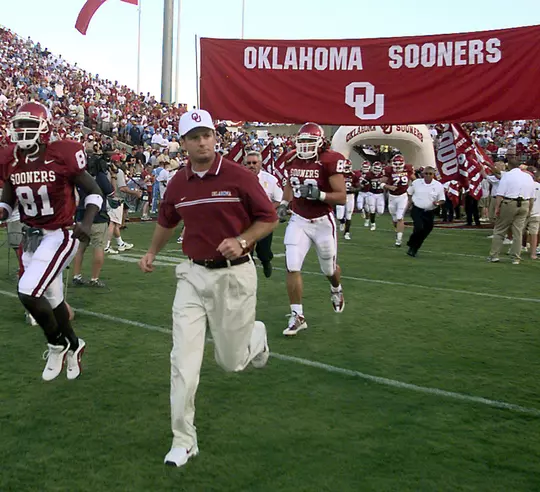
A New Millenium
I n 1999, the Sooners finished with a 7-5 record, actually cracked the Top 25 on two occasions and advanced to the Independence Bowl.
A date in Shreveport, La., qualified as a significant step after OU went a combined 17-27-1 in the four seasons before Stoops’ arrival.
In the minds of Stoops and those who played for him at the turn of the millennium, what transpired in Stoops’ rookie season helped propel OU to the national title the following year.
No question. Those guys in 1999 were every bit a part of the championship for getting it started.Bob Stoops
Norman said, “That season had a huge impact on us. The games we lost that year, we didn’t lose by a large margin in half of them. It was just us making mistakes and not being able to finish.”
Stoops said the turning point came with a 51-6 romp at home over reigning Big 12 champ Texas A&M during Homecoming Weekend. When Stoops arrived in Norman he was well-aware of the Aggies’ recent history against OU and their average winning margin of 30.0 points the previous three years.
“I felt we learned how to play four quarters and learned how to win against a good team,” Stoops said of the Sooners’ 45-point win.
“We remembered playing against Texas and Notre Dame (in 1999),” Burcham said. “We were out in front big in the first quarter, then both teams came back and ended up beating us. We were talking ‘remember that,’ talking about ‘finish’ and ‘play the whole game.’”
Norman most remembers being drenched in sweat before the 2000 season while chatting with receivers Andre Woolfolk, Damian Mackey and Curtis Fagan.
“We had just finished going through a grueling workout with coach Schmitty (strength and conditioning coach Jerry Schmidt),” Norman recalled. “We’re sitting there just dead tired. It was almost like we had the exact same thought at the exact same moment. One of us said, ‘Man, if we don’t win the national championship this season, I’m not coming back next summer. If we don’t win the national championship, what is this all for?’ That belief was steadily built in us. There were these small moments that gave us a little bit more belief.”
Stoops asked Heupel to address the team prior to the 2000 season. Heupel went down the schedule game-by-game and explained to teammates why going undefeated wasn’t such a crazy idea.
“I thought Josh was the one who would get everyone to start thinking that way,” Stoops said. “I believe we did our job as coaches getting people to work that way. But he as a player got everyone to start realizing, ‘Why can’t we do this?’”
No More Reminiscing
T hough 20 years have passed, Stoops has total recall of becoming national champs.
“I felt great about winning it then and still do,” Stoops said. “I know they’re terribly difficult to come by. I knew it was quite the accomplishment then.”
Stoops previously had won the 1996 national championship as defensive coordinator at Florida. Claiming another title in just his second season at OU made Stoops 2-0 in national championship games. “I was hoping winning these (championships) would become fairly routine,” Stoops said. “It did become routine getting to them, but we found out you can actually lose.”
OU later lost championship games in the 2003, 2004 and 2008 seasons and also fell short in a 2015 College Football Playoff semifinal in Stoops’ next-to-last year. Under coach Lincoln Riley, the Sooners have advanced to the last three playoffs, but have not reached the title game.
“You expect to win conference and national titles,” said Burcham, who attended OU games growing up in Oklahoma. “They’ve been in the hunt, but it’s hard.”
It’s really, really, really hard to win the national title. That’s what makes it one of the greatest programs – ever.Bubba Burcham
After two decades, the Sooners are still seeking their eighth national title. Since claiming their first national crown in 1950, OU is in the midst of the longest championship drought in the program’s history.
For Williams, winning the crown means a little bit more now.
“It’s one of those special deals where you really don’t know how hard it is to get to that point and win it,” Williams said. “You don’t appreciate how hard that run was until you’re 20 years down the road and other teams had an opportunity to do it, but weren’t quite able to finish it out.”
Calmus initially thought selfishly about winning the title.
“Being on OU’s last national championship team, you kind of wanted to hold onto that reign, but I’ve been ready to give up that reign for a long time now,” Calmus admitted. “I’d rather have seen us win a bunch of championships since then and be on top. It just shows how hard it is. Yeah, it’s time to give up that reign as being our last national champions.”
What was the secret ingredient in the championship season of 2000?
That team was full of guys who were humble and more concerned with the greater picture than themselves. That team had a great deal of character.Josh Norman
Williams had no trouble expressing what made the 2000 Sooners so special.
“That team was the (bleep),” Williams said succinctly. “I ain’t gonna lie. We really were, and that’s no disrespect to any other OU team.
“There were no egos. We didn’t have any problems with people thinking they were better than they really were. We loved to have fun and hit, and that was the most beautiful part of our team. We had a whole bunch of blue-collar workers who wanted to prove their worth. We just had some hard-nosed boys who wanted to play ball. That’s the thing I appreciated most. That was instilled, but we had that work ethic before we got there. Coach Stoops, Schmitty and other coaches brought it out of us.”


